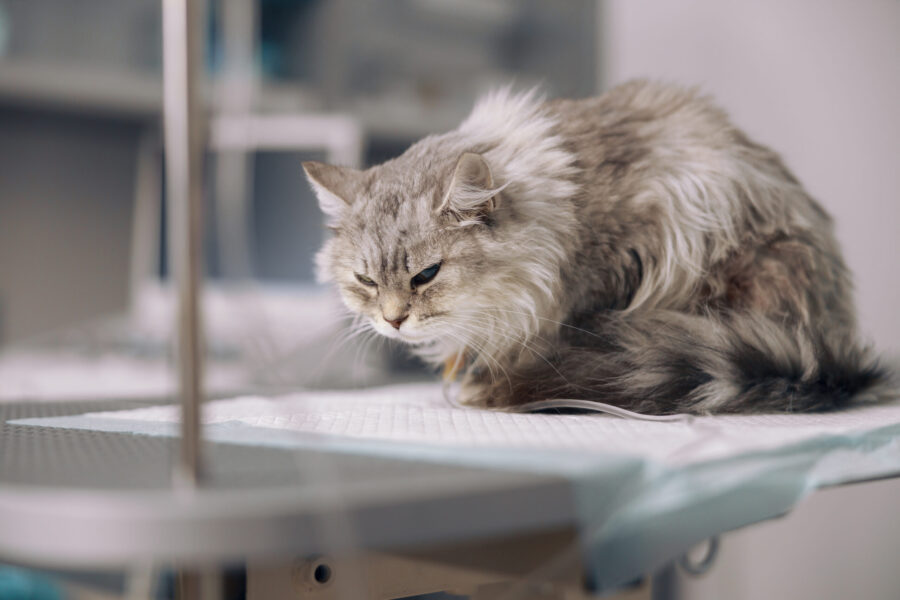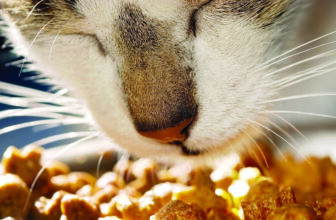
Check out our latest products
Cats are masters at hiding discomfort. This guide breaks down subtle behavioral and physical signs your cat might show when he’s in pain.
Cats are experts at concealing pain and discomfort. Their wild ancestors passed down this trait as a survival mechanism. But as our cats’ caretakers, we must learn to distinguish between subtle signs of pain and normal feline behavior. Knowing the signs your cat is in pain helps ensure his health, well-being, and quality of life.
Behavioral changes that could signal pain in your cat
When cats experience fear, they may hunch down, lower their heads and try to appear small. This same posture can also signal pain, making it crucial to closely observe your cat’s behavior.
One of the first things to look for in a cat experiencing pain is a change in activity. A cat that once loved to jump on countertops or chase their favorite toys may become less active. He may also hesitate to move, or avoid previously favored spots.
Veterinarian Dr. Sabrina Kong recalls a senior cat named Miso. His reduced mobility initially seemed like age-related slowing. But a closer look revealed debilitating arthritis causing significant discomfort.
-
Hiding or avoiding interaction
Cats in pain are more likely to hide, avoid interaction, and become less social. “If a cat spends more time hiding, avoids attention, or interacts less with other animals, these behaviors can be key indicators of pain,” confirms veterinarian Dr. Grant Little. Hiding is a defensive instinct that signals something is off.
-
Changes in grooming habits
Cats are meticulous groomers, so changes in this routine can be a red flag. Pain may cause a cat to over-groom the area where it hurts. The result is bald spots or raw skin. Conversely, discomfort may prevent him from grooming at all, leaving his coat greasy or matted.
Dr. Lisa Franzetta, L.Ac. notes that arthritis or injury can make it difficult for cats to twist into grooming positions. This often leaves to neglected hindquarters.
Cats rarely use vocalization to express pain, but changes in their usual sounds can be telling. A cat in discomfort might growl or meow more frequently. He may also purr at a lower, constant tone as a self-soothing mechanism. While purring often signals contentment, always consider the context.
Physical signs of pain in cats
Subtle shifts in how a cat stands, sits or walks can indicate problems. Cats with pain may move stiffly, hunch their backs, or avoid jumping altogether. Dr. Little cautions that limping or favoring one limb reflects an effort to avoid putting weight on a painful area.
-
Appetite and weight changes:
Pain can impact a cat’s appetite. According to Dr. Kong, cats with oral pain may paw at their mouths or tilt their heads while eating. Appetite loss or a refusal to drink can signal abdominal pain or nausea. Weight loss, dehydration, or gulping food without chewing may also signal discomfort.
-
Abnormal facial expressions:
The Feline Grimace Scale identifies specific facial changes that signal physical distress (see sidebar on page xx). Cats in pain often show these expressions along with sensitivity to touch. They might recoil when you gently press on sore areas.
Suddenly avoiding the litter box often signals pain. Cats may urinate or defecate outside the box because climbing in or squatting is painful. They may also avoid the litter box because of urinary blockages, gastrointestinal problems, or arthritis-related discomfort.
When to seek veterinary attention
If you notice any of the above signs lasting more than a day and/or worsening, it’s time to consult a veterinarian. Recognizing signs of pain in your cat early on allows for faster intervention and treatment.
Seek immediate evaluation for symptoms such as extreme lethargy, significant vocal changes, urinary problems, or a refusal to eat or drink. When cats experience acute pain, they often freeze, growl, or breathe abnormally, indicating a need for urgent help.
Knowing the signs your cat is in pain can make a significant difference to his well-being. Nobody knows your cat better than you, so trust your intuition. “If his spark dims, even slightly, it’s worth a vet visit,” Dr. Kong says. “Early intervention can turn whispers of pain into stories of recovery.”
Why cats hide pain – it’s a natural instinct
Cats evolved as both predators and prey. Because showing pain could make them an easy target for larger predators, they instinctively mask vulnerability to protect themselves. This survival strategy has carried over into their domestic lives, making it tricky for us to detect distress in our feline companions.
The Feline Grimace Scale
Tools such as the Feline Grimace Scale can help determine if your cat is in pain. It evaluates five key indicators of pain in a cat’s face:
- Ear position – flattened or rotated outwards
- Orbital tightening – squinting eyes
- Muzzle tension – looks elliptical instead of rounded
- Whisker position – whiskers are straight and pointing forward
- Head position – lowered, with chin towards chest
Using such assessments alongside behavioral observations can provide clues your cat is silently suffering.
Post Views: 1,420
Christine Caplan is a Certified Vet Tech, and a long-time PR veteran and content marketing expert who brings her unique understanding of social and digital media to connect dog lovers to brands both on and offline. She lives with three hounds – two “doxies” and a beagle/basset hound mix – who constantly teach her about life and companionship (mylifewithdogspdx.com).


![[PETHROOM] Cat Nail Clipper Trimmer for Indoor Cats with Circular Cut Hole (2mm) | Premium Sturdy Stainless Steel Blade Cat Claw | Safe, Easy, Accurate, Quiet & Fast | Avoid Overcutting](https://m.media-amazon.com/images/I/6156hi88deL._AC_SL1298_.jpg)
![[PETHROOM] Professional Eye Comb for Pets | Stainless Steel Tear Stain Remover for Cats & Dogs | Gentle Round-Head Grooming Tool | Compact & Portable for Eye Gunk Removal](https://m.media-amazon.com/images/I/71+W758uwXL._SL1500_.jpg)
![[petora] BRUSH ON ME Gentle Facial & Eye Comb for Dogs & Cats | Smooth & Stress-Free Tear Stain Remover | Fine-Tooth Grooming Tool with Rounded Tips | Comfortable Grip for Daily Pet Grooming](https://m.media-amazon.com/images/I/81hzVmjgV1L._SL1500_.jpg)









